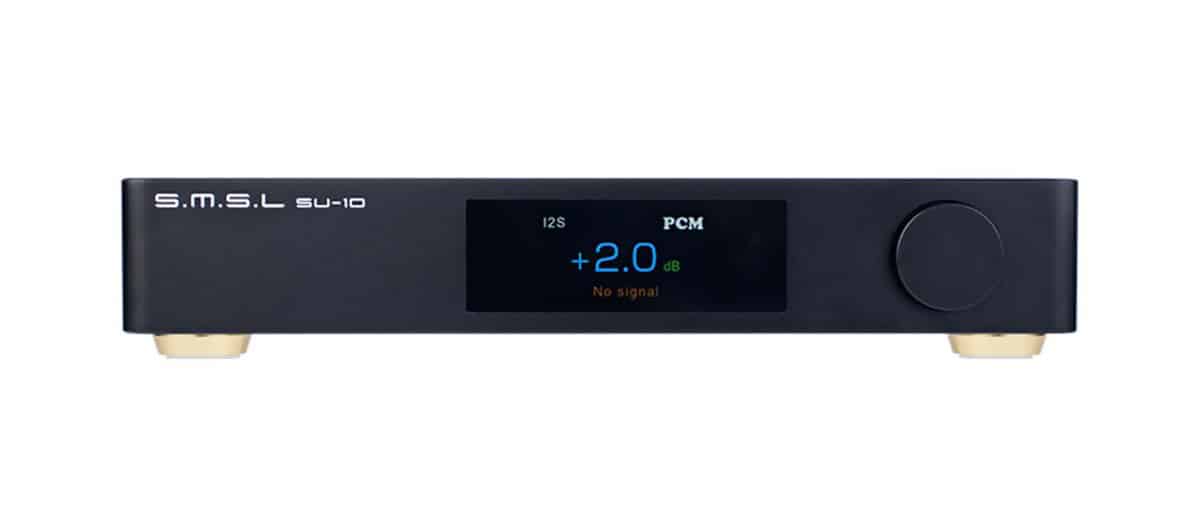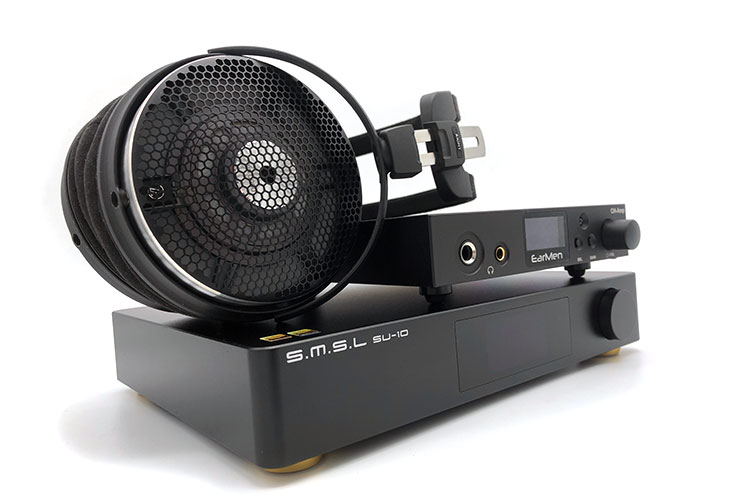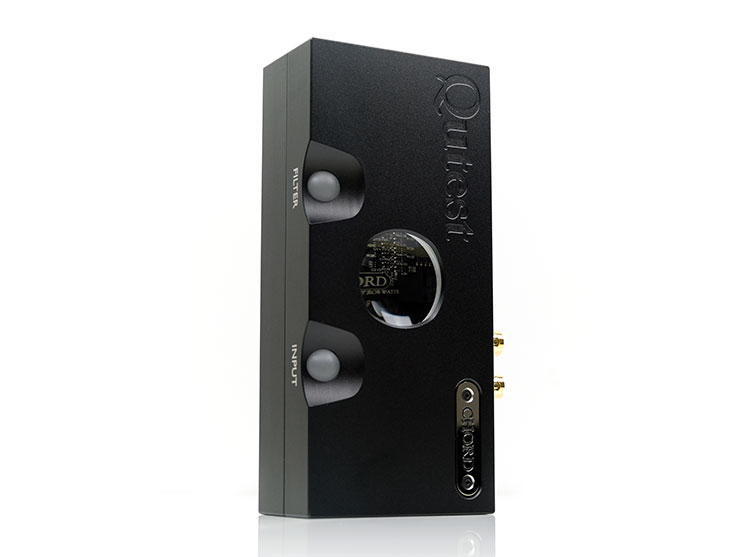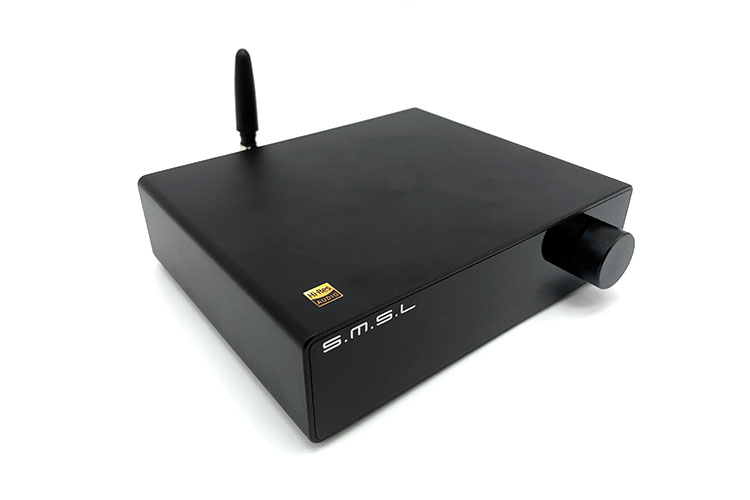Synergy
Pairings
Unlike other sources that greatly give bias to the chain, the SU-10 is a much easier piece of equipment to pair. The biggest factor when deciding which to choose, I’d say it’s the comparative quality of the amplifier to bring forth the potential of the SU-10.
Enriching the midrange, the SU-10 and EarMen CH-Amp combo was quite good as a start. And for a lighter vocal charisma, the Burson Conductor 3 Reference went on to being a pretty strong choice for its more refined characteristic.
Horns are bigger and more dynamic when paired with the CH-Amp pushing with it more air and weight. For a stiffer placement of objects, the C3R shows a stronger sense of image isolation due to its more incisive nature.
Using the Audio-Technica ATH-ADX5000 to analyze the SU-10 while paired with either of the two solid states above proved the balance of the DAC. The ATH-ADX5000 is a brutally honest pair of cans and the SU-10 not only managed to tame the excitable treble but also let it sing to its potential.
For a fuller-bodied feature, pairing the Sennheiser HD600 supplemented the baked-in tone of the SU-10. Bringing the stage closer, it rolls off the treble while giving the center stage a richer oomph.
With the HA-1A MK2 tube amplifier from Cayin, the ATH-ADX5000, and the HD600 predictably benefitted from the strengths of the tubes without any limitation from the SU-10. It sets a nice blank canvas for the tubes to begin adding flavor.
Select Comparisons
Chord Electronics Qutest
£1195
Technical
Even with its higher cost of ownership, the Qutest has built a great reputation, and for a good reason. For those who care, Chord is also slower in updating their products meaning their devices have a longer life cycle.
Even though it would set you back twice the asking price of the SU-10 in the US, what it will get you in return is the award-winning FPGA technology of Chord that has been digitally designed by Rob Watts.
In place of an ESS chip, the custom-coded Xilinx Artix 7 XC7A15T chip on the Qutest is equally future-proofed for DSD and PCM listening.
A standout feature of the Qutest is the dual BNC input located at the rear and the galvanically isolated USB port. Where Chord users will miss out though is with the more extensive range of inputs and outputs over at SMSL plus the SU-10’s ability to decode MQA.
Design
A déjà vu to my earlier critic towards the SU-10 being a simple device, the Qutest also happens to embrace the same straightforward approach. For such a tiny brick of a device, the Qutest while lighter at just 770g will also feel dense in the hand and appear quite premium in its black chassis.
Missing a volume wheel and display, the Qutest is instead taking some cues from the Hugo 2 with its prominent viewing glass and polycarbonate buttons.
It may be less intuitive to use at first than the traditional UI of the SU-10, but the transparent glass in the middle and the two buttons on the Qutest glow as feedback.
Performance
Chasing a different flavor, the Qutest is more suited to those looking to add something to their chain. It begins by gently loosening up on the low-end as it punches less hurried and more immense.
The coloration on the Qutest is very subtle but when compared to the precision and honesty shown by the SU-10, it is noteworthy that strings are getting an additional lift in the sub-bass and a girthier twang. Between the two, beats on the Qutest feel roomier but the tighter profile of the SU-10 allows subtleties to peak through easier.
Forming a step further imaging when it comes to vocal placement, the Qutest skillfully maintains its position to be the better DAC in forming texture and air. The Qutest also has more control in showing brilliance in the upper midrange without hinting toward sharpness.
Putting more emphasis on guitars, the SU-10 gives the plucking of strings a more chiseled edge and shimmer. The Qutest on the other hand as it gets comparably close in presence and energy is quite a bit more rounded and sweeter.
Horns and electric guitars are both shown as bigger in the SU-10. Not only is it sharper, but the increase in vigor makes it harder to isolate than the Qutest.
The same with violins, Qutest is the DAC for a more relaxed and dreamier rendition. With the leaner timbre of the SU-10, the serenade of the violin is more forward and edgy.
When it comes to layering and separation, the Qutest performs more maturely as it carefully lets the depth of each note flesh out less hurriedly. It is also capable of equally distributing the instruments as it images more evenly throughout the available space.
Burson Conductor 3 Reference
$1,744
Technical
Since the SU-10 is missing a proper stack companion in SMSL’s lineup, those looking for a one-and-done system will find the Conductor 3 Reference an enticing offer with its built-in 7.5W Class-A headphone amplifier.
But in SU-10’s defense, a usual setback of all-in-ones is that it becomes harder to upgrade incrementally unlike when you have separate components.
Focusing first on the digital assets of the C3R are the two available ESS Sabre chips just like the SU-10. But instead of the ES9038PRO, a more portable version of the same chip is used, the ES9038Q2M.
On the other hand, even though the C3R is single-ended only on paper with no XLR sockets in sight, it is just as sophisticated internally with a fully balanced circuit utilizing the merits of the implementation. The sound signature of the C3R down the line can also be altered by design with its swappable op-amps.
And if the SU-10 has two linear power supplies for its digital and analog stage, a huge selling point for the C3R is the five Max Current Power Supply (MCPS) Burson it installed to isolate its circuits. The MCPS of Burson raises the voltage frequency beyond what can be perceived by the ear.
Design
With the SU-10 as beefy as it is, it somehow stacks nicely on top of the C3R since it has a comparable width, only short a bit in height and depth.
Though since the cool case of the C3R is still a heatsink to the Class-A amplifier inside and warms up after a while, keeping the two in stack formation may end up transferring the heat to the SU-10.
Speaking of the cool case, it hides underneath four easily accessible screws that when removed will split the top lid off to expose the internals inside. Being electroplated to space grey, the chassis of the C3R is also catching the light more making it less subdued than the SU-10.
Both feature a display and a digital volume knob in front. The C3R however separates the duties of the volume knob into four buttons located just below the OLED screen.
What I like about the multifunction wheel of the SU-10 can also be said about the C3R. Even more so, I like how big and easy to grip the knurled volume knob Burson applied to the C3R.
Performance
One of the immediate things I noticed when listening to the C3R is that it was able to eke out a tiny bit more extra detail compared to the SU-10. It may be the thinner weight contributing but the C3R is the overall airier and more etched-sounding DAC.
The C3R has a charming character that pulls you in with an added thrill in the low end without slapping it in your face. Losing a bit in extension and dispersion, the SU-10 does try as well to maintain a well-balanced drum beat that doesn’t ask for too much attention.
Against the signature dry sound of the C3R that excels in pulling up nuances, the SU-10 focuses more on delivery. The SU-10 carries smooth and well-isolated vocals that also have more body considering the light yet expansive C3R.
Having an upper midrange that is brighter than the SU-10, the C3R could use some tweaking when it comes to gear pairing. But checking with a busy rock song, the C3R didn’t sweat when it comes to controlling its dynamics.
With a similar width in staging, the SU-10 shows weakness against the C3R when it comes to imaging and placement. Putting less emphasis on lighter notes for farther objects and placing images further away, the SU-10 is not as even as the C3R.
SMSL DO100
$239
Technical
With two full-sized XLR outputs, the DO100 is getting its balanced signal from two ES9038Q2M, a portable version of the same chip used by the SU-10. Aside from lacking support for MQA and its shorter list of inputs, the DO100 offers the same compatibility with music playback and the ability to stream through Bluetooth.
The analog section of the DO100 uses four OPA1612 op-amps and some audio-grade components. While also able to act as a preamplifier, it is a less complex design compared to the SU-10 which features a dedicated linear power supply and 21 sets of op-amps.
Design
While I did find the SU-10 reassuringly heavy when I took it out of its box, the same cannot be said for the DO100. Not that the DO100 is lightweight, but I just can’t feel the same premium heft bared by the more expensive DAC.
For some similarities, the black color scheme and the stealthy look match the description of both devices. The DO100 however is curved around the front tempered glass panel which is different from the flatter chassis of the SU-10.
With only a seven-segment and not a full-color display, the DO100 is a more entry-level offering from SMSL. To add, the volume wheel may be positively sturdy, but on the flip side, it is not as refined visually and physically.
Performance
I already suspected that the tonality of the two DACs would be similar. What is unsurprising though is the stark improvement the SU-10 brought to the table once I began going back and forth listening.
Not as dynamic as the SU-10, kick drums on the DO100 still manage to sound fast but not as tight. Like a lesser version of the SU-10, bass strings are delineated though a bit soft and rounded with the bite being not as prominent.
The upper midrange on the DO100 is sharper and thinner. Still, it does have an overall great tonal balance that only lags when we begin to talk about image definition as it smooths out quieter parts of a song.
It’s the kind of improvement in detail retrieval where you’ll hear people say it’s like listening to familiar music for the first time. The subtleties and presentation are much more fluent making any twist in vocal character more obvious and transparent.
And once the more attacking treble of the DO100 comes in, the SU-10 will seem like a breath of fresh air in comparison. Electric guitars tend to sound bigger and less isolated in the DO100 which for violins affects it to be not as natural and melodic.
Our Verdict
Breaking the mold in performance figures, the SU-10 may be a safe-looking DAC that follows the footsteps of other neutral SMSL DACs but it turns this into an asset in becoming a steadfast foundation of any system.
Not unless the priority is to use it for its Bluetooth streaming capability, then I’d recommend saving money by buying a cheaper unit.
Those who will take the plunge in appointing this DAC as the brain of their main audio chain will not be disappointed.
SMSL SU-10 Technical Specifications
- DAC: ESS ES9038PRO x 2
- Input: USB/Optical/Coaxial/Bluetooth/I2S/AES
- Output: RCA (2.6Vrms) /XLR (5.1Vrms)
- THD+N: 0.00005%
- Dynamic Range: 135dB (XLR), 128dB (RCA)
- Playback: 32bit/768kHz PCM, DSD512, MQA, MQA-CD
- Size: 240x185x39mm (WxHxD)
- Weight: 1.86kg










